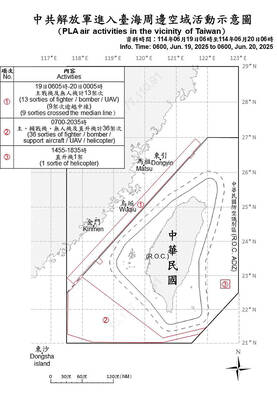Taiwanese scientists yesterday unveiled an “On-Site Earthquake Early Warning System” that they say could help mitigate quake damage and casualties.
The system was developed by the National Science and Technology Center for Disaster Reduction, the National Center for Research on Earthquake Engineering (NCREE), the National Center for High-Performance Computing and the Central Weather Bureau, which began working on the project in 2008.
NCREE researcher Lin Pei-yang (林沛暘) said the system mainly focused on two types of seismic waves, known as P-waves and S-waves.
“P-waves travel between 6km and 7km and arrive first, generally causing less damage [than other wave types],” Lin said. “S-waves travel only 3km or 4km and hit after P-waves, potentially causing greater damage.”
Lin said the opportunity to prevent disasters comes during the short interval between the arrival of P-waves and S-waves.
To test the system, Lin said researchers used data collected during the 921 Earthquake in 1999, which was centered in Jiji (集集), Nantou County. Researchers found that residents in Dali (大里), 43km away in what is now Greater Taichung, would have had about 7 seconds to react to the quake.
People in Hsinchu, which is located about 105km from the epicenter, would have had 17 seconds. People 152km from Jiji, such as those in Taipei, would have 27 seconds to take appropriate measures.
The magnitude 7.6 earthquake killed 2,415 people and injured 11,305, and caused about NT$300 million (US$10 billion) in infrastructure damage.
Lin said the system could be incorporated into other disaster-prevention systems, such as earthquake alarm broadcasts and the automatic train protection system used by the Taiwan High Speed Rail Corp.
Lin said the same technology has been used in Japan for 40 years, adding that the system needed more real-time testing before its benefits could be fully assessed.
ADDITIONAL REPORTING BY STAFF WRITER

A year-long renovation of Taipei’s Bangka Park (艋舺公園) began yesterday, as city workers fenced off the site and cleared out belongings left by homeless residents who had been living there. Despite protests from displaced residents, a city official defended the government’s relocation efforts, saying transitional housing has been offered. The renovation of the park in Taipei’s Wanhua District (萬華), near Longshan Temple (龍山寺), began at 9am yesterday, as about 20 homeless people packed their belongings and left after being asked to move by city personnel. Among them was a 90-year-old woman surnamed Wang (王), who last week said that she had no plans

TO BE APPEALED: The environment ministry said coal reduction goals had to be reached within two months, which was against the principle of legitimate expectation The Taipei High Administrative Court on Thursday ruled in favor of the Taichung Environmental Protection Bureau in its administrative litigation against the Ministry of Environment for the rescission of a NT$18 million fine (US$609,570) imposed by the bureau on the Taichung Power Plant in 2019 for alleged excess coal power generation. The bureau in November 2019 revised what it said was a “slip of the pen” in the text of the operating permit granted to the plant — which is run by Taiwan Power Co (Taipower) — in October 2017. The permit originally read: “reduce coal use by 40 percent from Jan.

China might accelerate its strategic actions toward Taiwan, the South China Sea and across the first island chain, after the US officially entered a military conflict with Iran, as Beijing would perceive Washington as incapable of fighting a two-front war, a military expert said yesterday. The US’ ongoing conflict with Iran is not merely an act of retaliation or a “delaying tactic,” but a strategic military campaign aimed at dismantling Tehran’s nuclear capabilities and reshaping the regional order in the Middle East, said National Defense University distinguished adjunct lecturer Holmes Liao (廖宏祥), former McDonnell Douglas Aerospace representative in Taiwan. If

‘SPEY’ REACTION: Beijing said its Eastern Theater Command ‘organized troops to monitor and guard the entire process’ of a Taiwan Strait transit China sent 74 warplanes toward Taiwan between late Thursday and early yesterday, 61 of which crossed the median line in the Taiwan Strait. It was not clear why so many planes were scrambled, said the Ministry of National Defense, which tabulated the flights. The aircraft were sent in two separate tranches, the ministry said. The Ministry of Foreign Affairs on Thursday “confirmed and welcomed” a transit by the British Royal Navy’s HMS Spey, a River-class offshore patrol vessel, through the Taiwan Strait a day earlier. The ship’s transit “once again [reaffirmed the Strait’s] status as international waters,” the foreign ministry said. “Such transits by